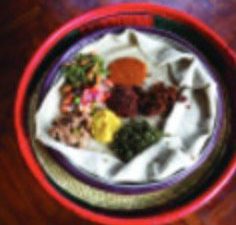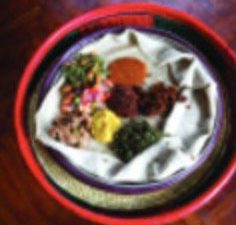4 Hours in Addis Ababa
February 1, 2017

1 DASHEN RESTAURANT
“A sack doesn’t stand without grain,” so the Ethiopian expression goes. So fuel up for your tour at Dashen, the recently relocated restaurant on DAR Sahara Street, not far from Africa Hall and the Kazanchis area of Western hotels (Hilton, Radisson Blu) where business meetings often take place.
If it’s a cool day, grab a table outside. Inside, gentle jazz plays, and there’s live music in the evenings. Order the national dish, injera, a big spongy “pancake” made from the Ethiopian grain teff. Slightly fold the injera to use as a utensil to scoop up meat or vegetables and sauces, from beef to spicy lentils, then follow with Ethiopia’s famously tasty coffee, or tej, a honey “wine.” Open 10:00 AM – 11:00 PM daily; Main courses 70-200 birr ($3.10-$8.90). dashenterararestaurant.com
2 HOLY TRINITY CATHEDRAL
The most hassle-free way to explore Addis Ababa is to pre-book a guided tour, including a van to get around, especially if you are traveling with colleagues, friends or family. If not, ask Dashen to book a taxi to Holy Trinity Cathedral, just off Niger Street. The ride will take you about ten minutes and should cost you around 150 birr ($7).
The country’s main cathedral, it’s the burial place of Ethiopia’s final emperor, Haile Selassie, and his wife, Menen. Selassie laid the cornerstone of the cathedral, which was inaugurated in 1945. A controversial figure, accused of oppression during his 45-year rule, his body was moved here in 2000, 25 years after his mysterious death, which was officially reported as natural causes. He was initially buried next to the Imperial Palace by his captors, under a toilet.
In front of the cathedral you’ll find the resting place of Sylvia Pankhurst (daughter of suffragette Emmeline), a feminist activist and protestor against Italy’s occupation of Ethiopia in 1936-41. Open 8:00 AM – 1:00 PM, 2:00 PM – 6:00 PM daily; 110 birr ($4.90).trinity.eotc.org.et
3 NATIONAL MUSEUM OF ETHIOPIA
It’s a ten-minute walk to the National Museum – head north on Niger Street and cross the Victory Monument roundabout to King George VI Street. Exhibits include Selassie’s throne and paintings by Ethiopia’s revered Afewerk Tekle. But what really marks the museum out is its archaeology and paleontology section, one of the most important centers for studies of human evolution in sub-Saharan Africa.
You’ll see replicas of “Lucy,” whose 3.2 million-year-old skeletal remains, discovered in 1975, caused a rethink in scientific understanding of human evolution: “We” were walking upright millions of years earlier than previously thought. There’s also Selam, who, at 3.3 million years old, is the earliest and most complete skeleton of a child human ancestor ever discovered. Open 8:30 AM – 5:30 PM daily; 10 birr ($0.50).
4 ETHNOGRAPHIC MUSEUM
Continue up King George VI Street and take the third exit at the large roundabout on to Algeria Street. Enter the leafy campus grounds of Addis Ababa University and walk down to the Institute of Ethiopian Studies and the Ethnographic Museum, housed in the former palace of Haile Selassie (he gets everywhere).
Selassie’s bedroom and marble bathroom have been preserved, along with gifts and souvenirs from his travels. The upstairs museum explores the country’s past and present, including agriculture, education and war, with weapons displayed from conflicts with invading Italian, Egyptian and Somalian forces. There’s also a room of religious paintings and crosses – Ethiopia was one of the earliest adopters of Christianity. Open 8:30 AM – 5:00 PM daily; 110 birr ($4.90).
5 ADDIS MERCATO
One of Africa’s largest markets, Addis Merkato is located in the Addis Ketema district, a 15-minute drive west. Jump into your tour van or flag down a blue and white Lada taxi outside the campus (negotiate a fare between 200-250 birr/$9-$11). On the way you’ll pass the city’s new Blue Mosque, St George’s Cathedral and City Hall, before a surge of human activity announces the start of the market.
Be warned: the sprawling market is full-on, loud, busy and a little edgy, certainly not for everyone, and a faranj (foreigner) with a camera sticks out like a sore thumb. Coming here with a local guide is recommended.
In the busy streets and maze-like passages virtually everything is on sale, from sheet metal to tires to beautiful clothing and colorful baskets used to store injera “pancakes.” The best areas to explore on foot are the fresh produce sections, where locals buy and sell chickens from cages, sacks of pre-ground coffee, spices, fruits and veggies. It’s open all day.
By Graeme Green




